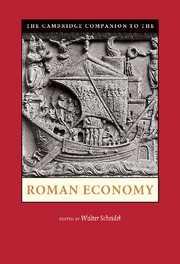Book contents
- Frontmatter
- Contents
- List of Figures
- Note on the Contributors
- Abbreviations
- The Roman world at the time of Marcus Aurelius
- 1 Approaching the Roman economy
- Part I Theory
- Part II Labor
- Part III Production
- 7 Raw materials and energy
- 8 Food production
- 9 Manufacturing
- Part IV Distribution
- Part V Outcomes
- Further reading*
- Bibliography
- Index
8 - Food production
from Part III - Production
Published online by Cambridge University Press: 05 February 2013
- Frontmatter
- Contents
- List of Figures
- Note on the Contributors
- Abbreviations
- The Roman world at the time of Marcus Aurelius
- 1 Approaching the Roman economy
- Part I Theory
- Part II Labor
- Part III Production
- 7 Raw materials and energy
- 8 Food production
- 9 Manufacturing
- Part IV Distribution
- Part V Outcomes
- Further reading*
- Bibliography
- Index
Summary
Although it would be attractive to offer a comprehensive survey of agriculture throughout the ancient Mediterranean, the Near East, and Western Europe, I intend to concentrate primarily upon the best attested and most productive farming regime, that of Italy, Greece, Western Asia Minor, North Africa, Baetica and Eastern Tarraconensis during the Principate and Early Empire. Within this affluent urban heartland of the Roman Empire, our sources and archaeological evidence present a coherent picture of market-oriented intensive mixed farming, viticulture, arboriculture, and market gardening, comparable, and often superior, in its productivity and agronomic expertise to the best agricultural practice of England, the Low Countries, France (wine), and Northern Italy in the mid-nineteenth century. Greco-Roman farmers succeeded in supplying a large urban population equal to, if not significantly greater than, that of early nineteenth century Italy and Greece, with a diet rich, not just in cereals, but in meat, wine, olive oil, fish, condiments, fresh fruit and vegetables. The most striking evidence comes from ancient skeletal remains, which reveal robust mean heights for Greeks and Romans and a high standard of health and nutrition. Protein and calorie malnutrition, caused by an insufficient diet based overwhelmingly on cereals, was very acute throughout eighteenth- and nineteenth-century Western Europe, and drove the mean heights of the Spaniards, Italians, and Austro-Hungarians as low as 158–162cm, comparable to the heights of poor peasants in the Egyptian Old Kingdom. The evidence from Roman Italy, on the other hand, allows us to estimate a mean height of 168cm, equal to that of Italian males just after World War II, and the material from Hellenistic Greece suggests a mean height of 172cm, a level not reached in modern Greece until the late 1970s.
- Type
- Chapter
- Information
- The Cambridge Companion to the Roman Economy , pp. 156 - 174Publisher: Cambridge University PressPrint publication year: 2012
- 15
- Cited by

